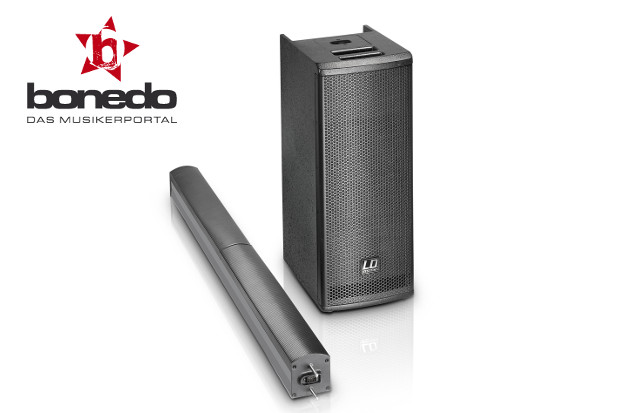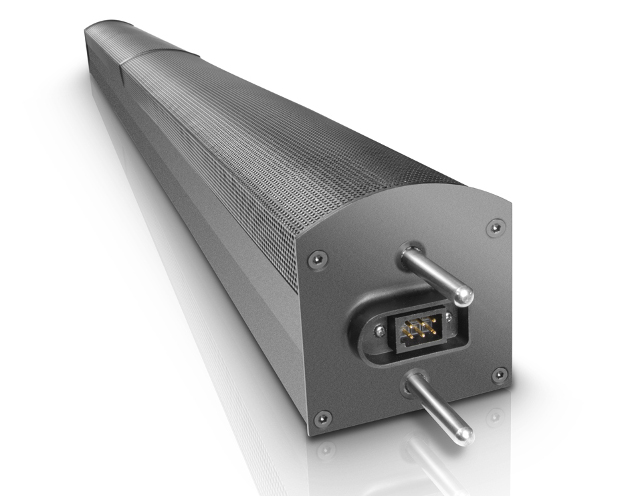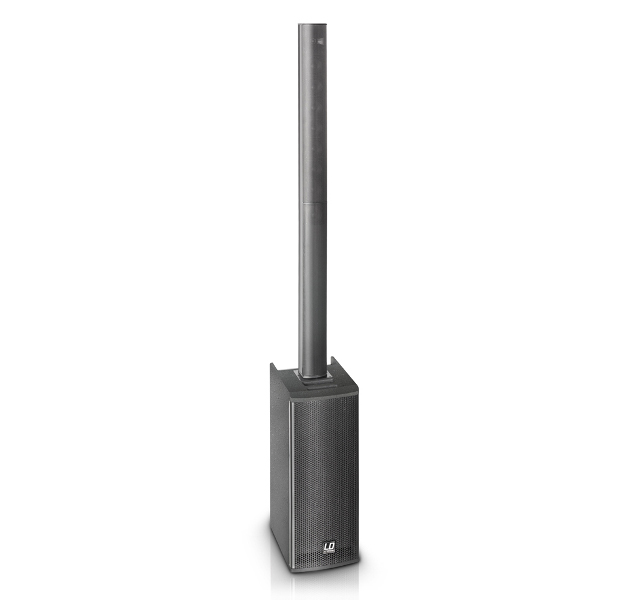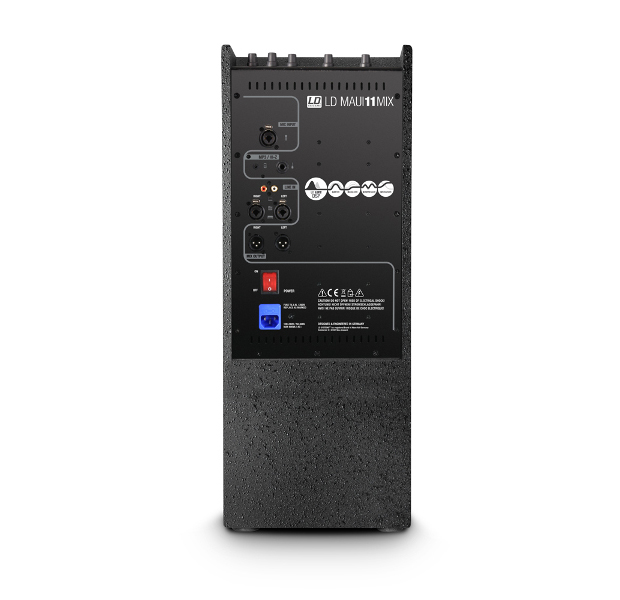LD Systems Maui 11 Mix – snaps into place, ready to go! – Test report from bonedo.de
The Maui 11 Mix from LD Systems was designed as a subwoofer with columns – a style now enjoying great popularity. It promises performance to rival standard compact PAs while delivering enhanced sound distribution. In addition, the line-array design is easily set up in no time. As well as the design’s low loss of sound pressure over distance, the manufacturer boasts of a 120-degree dispersion angle for the LD column. Then positioning the column centrally allows listeners standing to the left and right of the array to hear practically everything. Whether LD systems can really deliver on these promises and whether a system this extremely affordable system, at just under 700 euros, does the job required by small bands.

Details
The Maui Mix 11 consists of two components: the subwoofer including amplifier and mixer section, and also the passive mid- and high-range columns which form an array combining not just one but eight 3-inch speakers and one tweeter, each outputting 200 watts. The four lower speakers deal with the mid range from 180 Hz–1.5 kHz, with the top speakers handling the 180 Hz–7 kHz range. Horizontal dispersion angle is 120 degrees, vertical dispersion around 3-7 degrees. At least, that’s what the manufacturer claims. On top of the column also sits the 25-millimeter neodymium tweeter. It provides a brilliant response ranging from 7 kHz to 20 kHz. The subwoofer attaches to the column via a multi-pin connection featuring two steel pins at the foot of the column. According to the manufacturer, the Maui 11 Mix has a frequency response of 50–20,000 Hz and a maximum sound pressure level of 121 dB.
The sub features two 6.5-inch woofers, a three-channel mixing console and all the amplifier technology in addition to DSP. Analog input signals are converted with 24 Bit/48 kHz before passing through the integrated system technology LECC, consisting of the limiter, multiband equalizer, compressor and crossover. On top of the subwoofer sits the mixer with five potentiometers, or pots. Three of these mix the up to eight inputs, with the two others look after output volume and the bass level.
Four LEDs provide information on operating status (green), signal strength (green), the limiter (red) and the protection mode (red). At the back I find three XLR/jack combo sockets, a high-impedance 6.3 millimeter jack socket for instruments and two stereo inputs in cinch and mini-jack variations. These eight inputs are arranged across three channels and can be operated simultaneously but cannot be controlled individually. Two symmetrical XLR outputs, the power switch and the IEC socket with a bayonet connection including microfuse complete the features on the back. Once assembled, the system is 1.95 meters tall and weighs 23.6 kilos.
Experience
Unwrapped
So there they are, two packages fit to burst with sound. And I have to say, they fully live up to the easy-to-transport tag. Both components come out of the packaging easily although an extra pair of hands would have been helpful for the subwoofer. My first impression is a good one. The powder coating is fully intact and looks extremely robust. A swift check on the potentiometers integrated into the mixer section reinforces the high-quality aspect. These turn easily while offering a reassuring amount of resistance.
Assembly So does assembling the sound system go as smoothly as the unpacking stage? Yes, it can! And this is one huge benefit of this system: You just position the subwoofer in the center of the room and connect the column into the subwoofer – two clicks and it’s done. It’s convenience par excellence. No need here for hooking up any external mixer. All that’s left to do is to connect the power. And this takes just seconds.

To achieve a perfectly balanced sound at all times, the system relies on LD Systems LECC DSP technology. Sounds complicated, but it’s not – everything is configured in-house using internal equalizers, limiters and compressors. These processes are off limits to users, which makes sense given the type of use this system is designed for.
Getting started
So, I get the first LED to light up and turn the system on. Er, have I forgotten something? Oh yes, I haven’t plugged in the mini jack cable of my MP3 player into the bottom of the column. I take the lazy option and stick the cable in “hot”, with the volume and master potentiometer set at 12 o’clock. The result: glorious silence! I try it again straight afterwards with two jack plugs in the line input. Again, when I insert the plugs there’s not a sound to be heard. Even the cinch plugs, which normally always induce a short hum, create no sound at all. The “open ends” are also silent. Even cables hanging out without being connected to an instrument or end device don’t cause any humming. Fantastic! All this means that during a show and with the system turned right up, you can add or disconnect equipment without risking a heart attack.
Potentiometers
One pot controls the microphone channel, another does the MP3/Hi-Z input and a third regulates the cinch/XLR inputs (line). So I can connect an MP3 player via a stereo mini jack, and also hook up a guitar for example, and additionally plug in my computer via a stereo cinch cable as well as have a stereo keyboard hooked up via the line-in combo sockets. At this point the volume pots turn into group master controllers and I have to adjust the volume of the grouped components on the devices myself. Not a massively elegant solution but I can live with it. One thing to note here though: if you use all four line inputs, the group volume does dip by a few decibels, although not on the MP3/Hi-Z input.

Sound
The Maui 11 Mix produces a pleasing, balanced sound. The setting options are not something I miss, because the ability to control the bass level via the relevant potentiometer on the sub is, in my opinion, sufficient. There is a point however, when you turn up the volume on the system, where you do notice the integrated compressor. But it has to be said, the two 6.5-inch speakers aren’t really designed to cope with sound levels that make you wince. So, if ear-bursting sound is what you’re after, you’d need to connect a second sub via the mix outputs.
The line array technology on our test model performs well: standing eight meters away from the column, the volume felt no different to when I moved to within one meter of the system. And in smaller rooms, the system is really worth its weight in gold. Other systems have the drawback that the sound blows your eardrums if you’re in the first two rows, and it dies on you in row ten.
So what about side sound dispersion performance, the second big virtue of line array systems? LD Systems advertises this angle as being 120 degrees. Well, maybe, maybe not. When standing directly next to the column left or right, I could hear the music, which is fine for a party. But when it comes to a concert where you have brilliant treble range or need to hear lyrics clearly, the angle proved to be more like 60-80 degrees.
If you a connect a dynamic microphone, you notice two things. Firstly, the feedback is virtually non-existent. To produce feedback yourself with the system turned up pretty high, you need to be positioned right next to the column and have the mike trained directly at the speaker. So, for a concert in a bar or a smaller-scale singer-songwriter gig, you can easily position the system behind the band and just use it as both a monitor speaker system and PA system.
Secondly, the system lacks an equalizer. When the system was set up to satisfy my bass requirements for music playback, vocals were muffled. The integrated Low Cut feature in the mic input (at 120 Hz) isn’t really up to the job of correcting this sound. But a small mixing console doesn’t exactly strain the bank or the muscles that much – and it’s part of many musicians’ standard portable kit anyway.

Summary
The Maui 11 Mix from LD Systems is an affordable column system that is easy to set up and produces consistent sound. For DJs or smaller concerts, it comes highly recommended from me. Other pluses with this system are its elegant appearance, the attractive price, low loss of sound pressure as well as its outstanding feedback performance. Anyone seeking greater sound control however would definitely need an extra mixer. And if more bass is what you’re after, you’ll need to requisition a second active subwoofer.
For
+ Easy-to-assemble system
+ Clear control panel
+ Integrated 3-channel mixer
+ Elegant appearance
+ Well-balanced sound, good side sound
+ Low loss of sound pressure + Excellent feedback resistance
Against
– No manual sound control option
– Tweeter dispersion angle only 60-80 degrees
– Microphone input has no phantom feed
Features
– Mono line-array PA system with subwoofer
– Height 1.95 m
– Weight: 23.6 kg
– Max SPL (peak): 122 dB
– Max SPL (continuous): 114 dB
– frequency response: 50Hz – 20 kHz
– Dispersion angle (H x V): 120º (average horizontal)
– Fully digital signal processing: LECC-DSP using 24 Bit and 48 kHz
Column:
– Speaker units: 8 x 3″, 1 x 1″ tweeter
– dimensions (W x D x H): 9x 1300 x 95 mm
Subwoofer:
– Speakers: 2 x 6.5″
– dimensions (W x D x H): 256 x 650 x 355 mm
Integrated mixer:
6 x line inputs (2 x cinch, 2 x XLR/jack combos 1 x 3.5 mm stereo jack)
1 x microphone input
1 x Hi-Z input
3 x volume controls for input sections
2 x speaker outputs (in addition to master, separate subwoofer control)
2 x XLR output connectors
___________________________________________
Source: bonedo.de, Germany: http://www.bonedo.de/artikel/einzelansicht/ld-systems-maui-11-mix-test.html
Author: Manuel Horstmann
Click here to learn more about the LD Systems Maui 11:
http://www.ld-systems.com/en/series/maui-series/maui-11-mix-compact-column-pa-system-active-with-integrated-3-channel-mixer-black/
http://www.ld-systems.com/en/series/maui-series/maui-11-mix-w-compact-column-pa-system-active-with-integrated-3-channel-mixer-white/
Leave a Comment
You must be logged in to post a comment.












